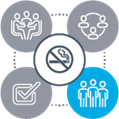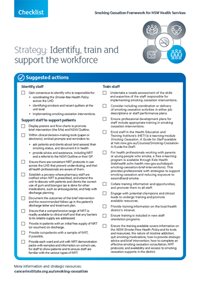Strategy: Identify, train and support the workforce

Identifying dedicated staff to implement smoking cessation intervention ensures clarity
Clarifying roles and responsibilities in smoking cessation is an essential step in clinical environments characterised by competing demands and multiple pressures.
It can be too easy for smoking cessation to be seen as someone else’s job, or for health professionals to be uncertain about who else may have already addressed a patient or client’s smoking.
With identified staff to lead smoking cessation care, roles and responsibilities are clear. Local health districts (LHDs) can more easily understand what training is needed, and where.
For health professionals to feel motivated and confident to help someone quit, they need access to the latest knowledge and skills, particularly in regard to providing nicotine replacement therapy (NRT).
This will also help combat the stigma and negativity often associated with caring for smokers.
Tailored and responsive training needs to be ongoing
Training should be provided in a format and delivery mode to suit the requirements of the service, its staff and patients/clients. It can involve workshops, on-site training, in-services, lunch-and-learn sessions, e-learning modules, ‘train the trainer’ workshops, academic detailing, forums, presentations and conferences.
Resources and tools need to be accessible
Doctors, nurses and allied health professionals need accessible and clear resources, reminders and tools to support smoking cessation within routine clinical care. Resources can be linked to training, and training is most effective when followed up with tools and other practice supports.
It is also beneficial to involve local clinicians and health professionals in the development and promotion of training and resources specific to the needs of the local workforce.1,2
NRT needs to be readily available across the LHD
NRT is a key pharmacological intervention used to support people to quit smoking and is crucial to the success of smoking cessation interventions. Staff need access to NRT for patients and clients, as well as support and training in its correct use.
LHDs may need to consider identifying a budget to ensure the availability of NRT to those accessing the NSW health system.
Success factors
1. Promote Quitline
- All health professionals can encourage patients or clients who smoke to call the NSW Quitline on 13 7848 (13 QUIT); or health professionals can make a direct referral to the NSW Quitline. Order Quitline brochures and posters to promote the service to staff, patients and clients.
- NSW Quitline advisors are trained professionals who provide a free call-back service, including Aboriginal and multilingual advisors. Smokers who use the call-back service and receive up to six calls can double their chance of successfully quitting.
- Promote NSW Quitline to all staff as part of strategic communications on smoking cessation.
2. Smoke-free workforce
- Clinicians and other health professionals who are non-smokers may feel more confident addressing smoking in patients and clients.
- Promote ‘healthy workforce’ initiatives for all staff, including senior executives and management. Promoting activities such as exercise, meditation or healthy cooking classes supports teamwork and productivity, and supports staff members who may be trying to quit smoking.
- Get Healthy at Work is a great place to start: gethealthyatwork.com.au
- All staff who want to quit are supported with up to four weeks free NRT per year. It is good practice to supplement this with a consultation with a relevant smoking cessation counsellor to ensure correct NRT use, and providing a referral to the NSW Quitline. Staff are encouraged to contact staff health or human resources to access this support.
 Suggested actions
Suggested actions
| Identify staff | |
Gain consensus to identify who is responsible for:
| |
| Support staff to support patients | |
| Display posters and flow charts to promote brief intervention (the 5As) and NSW Quitline. | |
Within clinical decision-making tools (paper or electronic), embed prompts and reminders to:
| |
| Ensure there are consistent NRT protocols in use across the LHD that prevent under-dosing, and that all health professionals are aware of them. | |
| Establish a process where pharmacy staff are notified when NRT is prescribed, and attend the unit to discuss with patients and clients the correct use of gum and lozenges (as is done for other medications, such as anticoagulants), and help with discharge planning. | |
| Document the outcomes of the brief intervention and the recommended follow-up in the patient’s discharge letter and treatment plan. | |
| Ensure that a comprehensive range of NRT is readily available to clinical staff and that any barriers to its reliable supply are addressed. | |
| Provide in-patients with an initial free supply of NRT (or vouchers) on discharge. | |
| Provide out-patients with a sample of NRT, if possible. | |
| Provide each ward and unit with NRT demonstration packs, including samples and information on correct use, for staff to show patients and to ensure staff are familiar with the various types of NRT. | |
| Train staff | |
| Undertake a needs assessment of the skills and expertise of the staff responsible for implementing smoking cessation interventions. | |
| Consider including coordination or delivery of smoking cessation activities in either job descriptions or staff performance plans. | |
| Ensure professional development plans for staff include appropriate training in smoking cessation interventions. | |
| Enrol staff in the Health Education and Training Institute’s (HETI’s) e-learning module Smoking Cessation: A Guide for Staff. | |
| For health professionals working with parents or young people who smoke, a free e-learning program is available through Kids Health. This provides professionals with strategies to support smoking cessation and reduce exposure to secondhand smoke. | |
| Collate training information and opportunities, and promote them to all staff. | |
| Engage with potential champions and clinical leads to undergo training and promote available resources. | |
| Provide training information on the LHD’s intranet. | |
| Ensure training is included in new staff orientation programs. | |
| Ensure the training available covers information on the NSW Health Smoke-free Health Care Policy and its tools and resources; the nature of nicotine addiction; quit smoking medications; how to provide strategic advice and brief intervention; how to complete an effective smoking cessation consultation; NRT protocols; and availability and access to smoking cessation supports in the district. | |
- Wiggers J, Vashum K, Wolfenden L, Yoong S, Paul C, Williams A, Bowman J. Implementing nicotine dependence and smoking cessation care in hospitals: an evidence check rapid review brokered by the Sax Institute (www. saxinstitute.org.au) for the NSW Ministry of Health, 2016.
- Slattery C, Freund M, Gillham K, Knight J, Wolfenden L, Bisquera A, Wiggers J. Increasing smoking cessation care across a network of hospitals: an implementation study. Implementation Sci 2016;11(1):28.

